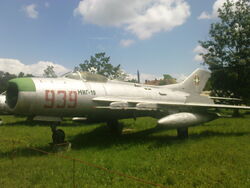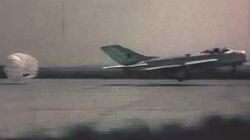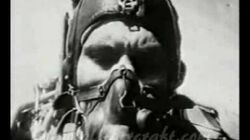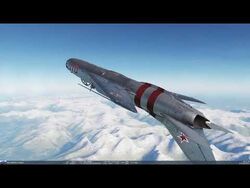
A retired MiG-19PM in the National Museum of Military History, Sofia.

Mig-19 fighter jet 米格-19战斗机
A-Mig-19 fighter in action.

MiG 19 in action
A mig-19 fighter in action.

MiG-19- The Farmer's plane
A mig-19 fighter in action and a look around it's cockpit.
- Not to be confused with: Moody's Investment Grade, Meadowbrook Insurance Group, Minor Injury Guideline, Made in Germany (gaming clan), Mach Interface Generator, Memory Interface Generator, Municipal Infrastructure Grant (South Africa), Mortgage Indemnity Guarantee (real estate) or Molybdenum Inert Gas (welding) or any of the other plethora of acronyms that form in to "MiG".
History[]
The Mikoyan-Gurevich MiG-19 (Russian: Микоян и Гуревич МиГ-19; NATO reporting name: Farmer) is a Soviet second generation, single-seat, twinjet fighter aircraft. It was the first Soviet production aircraft capable of supersonic speeds in level flight and the world's first mass-produced supersonic aircraft. It is comparable U.S. "Century Series" fighter was the North American F-100 Super Sabre, although the MiG-19 primarily fought against the more modern McDonnell Douglas F-4 Phantom II and Republic F-105 Thunderchief over North Vietnam.
During their service with Soviet Anti-Air Defense and in East Germany, MiG-19s were involved in multiple interceptions of Western reconnaissance aircraft. The first documented encounter with a Lockheed U-2 took place in the autumn of 1957. The MiG-19 pilot reported seeing the aircraft, but could not make up the 3,000 m (9,800 ft) difference in altitude. When Francis Gary Powers's U-2 was shot down in the 1960 incident, one pursuing MiG-19P was also hit by the salvo of S-75 Dvina (NATO: SA-2 "Guideline") missiles, killing the pilot Sergei Safronov. In a highly controversial incident, on 1 July 1960, a MiG-19 shot down an RB-47H (S/N 53-4281) reconnaissance aircraft in international airspace over the Arctic Circle with four of the crew killed and two captured by the Soviets (they were released in 1961). In another incident, on 28 January 1964, a MiG-19 shot down a T-39 Sabreliner which had strayed into East German airspace while on a training mission; all three crewmembers were killed.
The Vietnam People's Air Force (VPAF) began receiving the MiG-19 at the end of Operation Rolling Thunder, which ended in 1968. Despite their limited numbers, MiG-19s were involved in extensive combat during Operations Linebacker and Linebacker 2. The VPAF claimed seven victories over U.S. aircraft using the MiG-19, all of which were F-4 Phantom IIs.
Data[]
| Category. | Statistic. |
|---|---|
| First flight. | 1952. |
| Retired on. | Officially ion 1974. As of April 2002, the Korean People's Army Air and Anti-Air Force was reportedly operating about 100 Shenyang J-6 and/or MiG 19s, but they were in bad shape due to both the lack of spars and the necessary skilled labour. Some remain as civil warbirds. |
| Major contractor(s). | Mikoyan-Gurevich. |
| Dose it use nukes or cruse missiles. | No. |
| Flight ceiling | 57,400 feet(ft)/17,500 meters(m). |
| Top speed. | Mach 1.35 (1,452 km/h (902 mph, 784 kn) at 10,000 m (33,000 ft)). |
| VTOL. | No. |
| Range. | 2,200 km (1,400 mi, 1,200 nmi) with 2 × 760 l (200 US gal; 170 imp gal) drop tanks at 14,000 m (46,000 ft) |
| Crew. | 1 |
| Nationality(s). | Soviet. |
| Class. | Fighter. |
| Rate of climb. | 177.8 m/s (35,000 ft/min) |
| Links. | https://military-history.fandom.com/wiki/Mikoyan-Gurevich_MiG-19, https://aerocorner.com/aircraft/mikoyan-gurevich-mig-19/, https://www.warhistoryonline.com/instant-articles/mig-19.html, https://aerocorner.com/aircraft/mikoyan-gurevich-mig-19/, https://weaponsandwarfare.com/2015/09/28/mig-19/, https://weaponsandwarfare.com/2015/09/28/mig-19/, http://old.vko.ru/pictures/2006_26/42_01.jpg, https://en.wikipedia.org/wiki/Mikoyan-Gurevich_MiG-19 and https://web.archive.org/web/20140203010754/http://old.vko.ru/pictures/2006_26/42_01.jpg. |